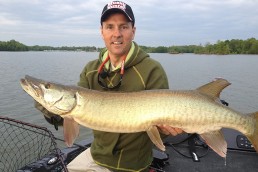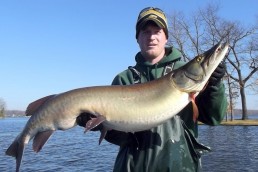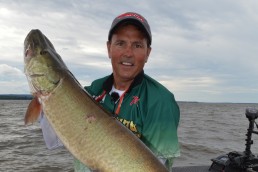Can Little Coves Produce Big Muskies?
SHARE THIS POST
Prior to hooking up with this particular giant, I was admittedly skeptic that small coves, little cuts and tiny bays could be a good summer muskie location. That all changed with one fateful cast while bucktail fishing for muskies. Here’s the scoop on one of my biggest muskies, which came from such a spot.
Pre-conceived notions
Generally, when coves are small, I always approach them cautiously, with very little on/off trolling motor noise. Instead, I prefer to bomb extra long casts at them while keeping my boat outside the target zone as much as possible. I also tend to make casts at various angles in the confined area by starting off to one side of the cove, then eventually shifting hard to the opposite side to fire casts at exaggerated angles back over the same water. As it turns out, this ended up being the key to triggering the strike. I actually wrote about this very tactic way back in 1978 in my first book, Bucktail Fishing for Muskies, which you can still find on ebay occasionally. Essentially, it involves placing your lure over a known muskie at various angles in order to trigger a stronger response. This little reverse-angle casting trick has worked countless times, and not surprisingly it scored yet again.
Prior to this moment and this drift, I had not fished any big blades the entire day, relying instead on my trusty little 500 Buchertail Tinsel to get me through the day. A damaged shoulder from an injury a few years back has now limited my reps with big blades. I tend to fish them now in spurts. Besides, I was consistently scoring on good muskies daily with the downsized offering. Yet, something inside of me said it was time to snap on the big blades. My fishing partner Chas even made the comment, “Oh boy! JB is pulling out the big guns now. Look out!” How prophetic this turned out to be.
The presentation
Admittedly, the Buchertail 800 Tinsel in black/chartreuse, a twin 8 in-line spinner by design, has been an evening favorite. I have filmed many evening TV segments with the Twin 8 Tinsel over time. However, I usually take off the middle treble and then oversize the rear hook. As many of you already know, I have always favored a single rear treble design. Single treble spinners foul far less, and go thru weeds far better. Arguably, they also hook big fish more solidly. At the very least, it is far easier to unhook a muskie afterwards, too. I generally fish this lure on a St. Croix 8-foot, 6-inch heavy power stick, with a large high speed baitcaster like the Daiwa Lexa400H, 80-pound braid and a heavy-duty solid wire leader, sporting at least one ball-bearing swivel. This is precisely how I was rigged up on this pass.
Are you enjoying this post?
You can be among the first to get the latest info on where to go, what to use and how to use it!
Reverse-angle for the win
A little over 10 minutes into our casting pass, we were already thru the entire cove with no action. Even though conditions seemed perfect, there was no sign of muskie presence at all. This is where the story gets very interesting, and might provide one of the best lessons on reverse angle casting. Instead of simply continuing our motion out of the cove, and on to another spot, I abruptly turned the bow hard to the port side, so we could rifle a few more casts back across the cove from the completely opposite direction. The very first cast I launched in this reverse angle fashion turned out to be the cast. By the way, this is all verified by simply watching the episode on YouTube, “The Hunt for Goliath.”
Felling Goliath
A summer muskie fishing tip is when casting blades over any shallow area during the summer period is to first synchronize my reel engagement simultaneously with lure splash entry. Immediately afterwards, I begin my retrieve with an aggressive burn that bursts the spinner quickly forward and upward, creating a bulge. About 8 to 10 turns into the burst retrieve, I then back off the burst a tad and actually let the lure descend a touch. About halfway back, I repeat the process. Finally, I will begin one more burst as the lure nears the boat and then finish with a figure 8 that emulates this same technique. I was only about halfway through this whole procedure when my rod doubled and I instinctively reared back in a power hookset.
A giant head and thick, elongated body suddenly surfaced, revealing a much larger muskie than we expected. Chas immediately exclaimed, “Oh my gosh!” A classic battle ensued, accented by incredible drag-screaming, line-stripping power runs and barrel rolls. When it was all over, a giant muskie barely fit inside the net bag.
What a Fish
Both of us were abruptly stunned by all the immediate visual dimensions on this fish; particularly as it relates to comparable muskies in the mid summer period. Not only was this fish long, but it had a giant, oversized head and was extra thick across the back, proportionally from head to tail. In fact, the oversized head is where Chas quickly came up with the nickname Goliath referring to the biblical giant and his oversized head and giant frame. It also had fabulous girth proportions throughout the entire body, almost like a power lifter. This fish was literally thick from head to tail. Finally, Goliath was simply a perfectly marked, super healthy trophy muskie without a single blemish. I sincerely believe it had never been caught before. It had no hook scars anywhere. Yet, if I hadn’t made that reverse angle cast, Goliath would still be swimming without a scar. Instead, it has at least one!
MWO
More muskie fishing articles by Joe Bucher link.
#MWO
MWO
SHARE THIS POST
Did you enjoy this post?
You can be among the first to get the latest info on where to go, what to use and how to use it!
Joe Bucher
Joe Bucher is a Freshwater Fishing Hall of Fame Legendary Angler, book author, lure designer and host of Fishing with Joe Bucher TV series.



